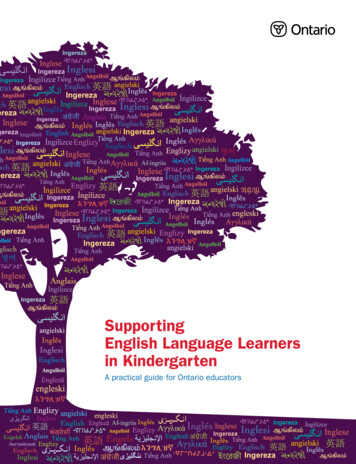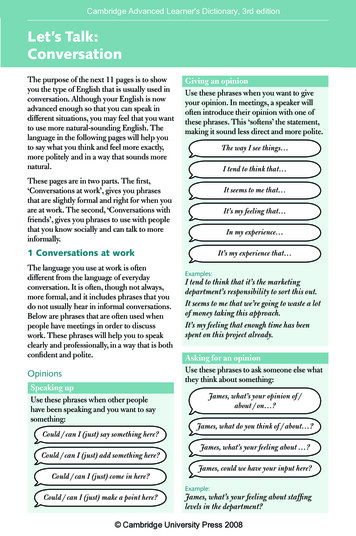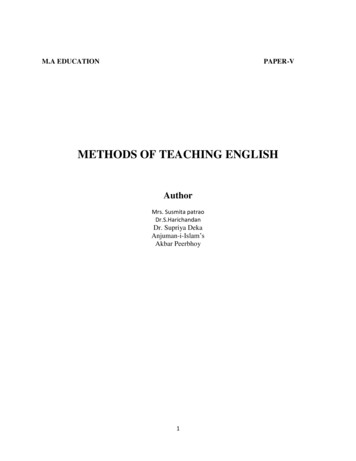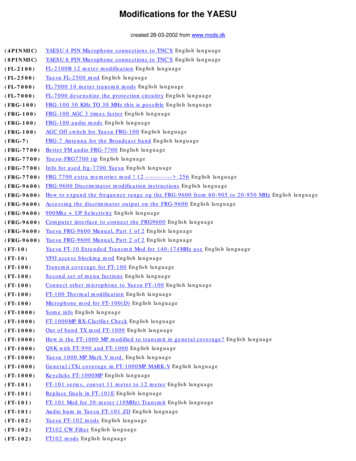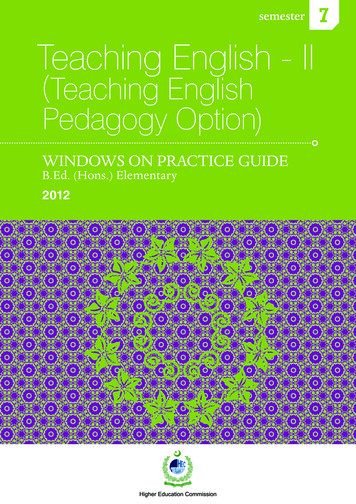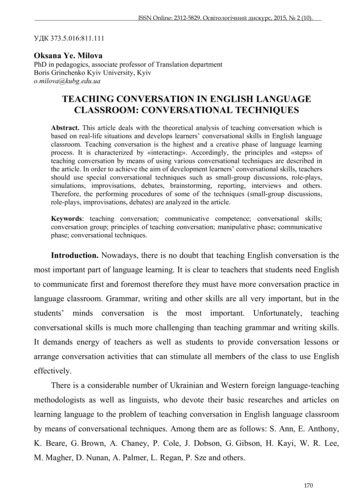
Transcription
ISSN Online: 2312-5829. Освітологічний дискурс, 2015, 2 (10).УДК 373.5.016:811.111Оksana Ye. MilovaPhD in pedagogics, associate professor of Translation departmentBoris Grinchenko Kyiv University, Kyivo.milova@kubg.edu.uaTEACHING CONVERSATION IN ENGLISH LANGUAGECLASSROOM: CONVERSATIONAL TECHNIQUESAbstract. This article deals with the theoretical analysis of teaching conversation which isbased on real-life situations and develops learners’ conversational skills in English languageclassroom. Teaching conversation is the highest and a creative phase of language learningprocess. It is characterized by «interacting». Accordingly, the principles and «steps» ofteaching conversation by means of using various conversational techniques are described inthe article. In order to achieve the aim of development learners’ conversational skills, teachersshould use special conversational techniques such as small-group discussions, role-plays,simulations, improvisations, debates, brainstorming, reporting, interviews and others.Therefore, the performing procedures of some of the techniques (small-group discussions,role-plays, improvisations, debates) are analyzed in the article.Keywords: teaching conversation; communicative competence; conversational skills;conversation group; principles of teaching conversation; manipulative phase; communicativephase; conversational techniques.Introduction. Nowadays, there is no doubt that teaching English conversation is themost important part of language learning. It is clear to teachers that students need Englishto communicate first and foremost therefore they must have more conversation practice inlanguage classroom. Grammar, writing and other skills are all very important, but in Unfortunately,teachingconversational skills is much more challenging than teaching grammar and writing skills.It demands energy of teachers as well as students to provide conversation lessons orarrange conversation activities that can stimulate all members of the class to use Englisheffectively.There is a considerable number of Ukrainian and Western foreign language-teachingmethodologists as well as linguists, who devote their basic researches and articles onlearning language to the problem of teaching conversation in English language classroomby means of conversational techniques. Among them are as follows: S. Ann, E. Anthony,K. Beare, G. Brown, A. Chaney, P. Cole, J. Dobson, G. Gibson, H. Kayi, W. R. Lee,M. Magher, D. Nunan, A. Palmer, L. Regan, P. Sze and others.170
ISSN Online: 2312-5829. Освітологічний дискурс, 2015, 2 (10).The goal of the article is to analyze the conversational techniques which areperformed in English language classroom in the teaching conversation process.The main researches. It is common practice for general-purpose second foreignlanguage programmes to incorporate the teaching of speaking skills. The recognition ofspeaking as a «crucial part» [7] of a second language curriculum is reflected in «generalmethodology texts», as well as in «second language syllabuses» [12, 229]. Speaking is«the process of building and sharing meaning through the use of verbal and non-verbalsymbols, in a variety of contexts» [3, 13]. Despite of its importance, teaching speaking hasbeen undervalued for many years. English language teachers have continued to teachspeaking just as a repetition of drills and memorization of «artificial dialogues whichpurport to be developing learners’ speaking skills» [12, 230]. As a result many Englishlanguage learners have developed the «ability to speak both accurately and appropriately»[12, 237]. In the other words, they are able «to speak reasonably correct and even fluentEnglish» [9, 3] but they are unable to engage in «on-going, interactive, mentally satisfyingconversation» [9, 3]. They don’t take the initiative to say more, they satisfy themselveswith short answers, they are not able to keep up long turns in conversation due to a lack ofconversational skills. The ability to take part in a conversation is «believed to be a part oflearner’s communicative competence, the ultimate goal of second language learning»[12, 229]. Therefore teaching conversational skills in the frame of teaching speaking canimprove learners’ confidence how to communicate in an informal setting using basicvocabulary and sentence structures. This is the way the learner’s conversationalcompetence is developed.Teaching conversation is the highest phase of the language learning process which ischaracterized by «interacting» (direct conversation) [4, 2] between the members of aconversation (communicative) group. Direct conversation practice for students learningEnglish may occur in regular classroom surroundings or in non-academic environmentssuch as conversation clubs. English conversation clubs are organized by teachers andstudents who want to practice English in more congenial atmosphere than the classroommay allow. The meetings of conversation clubs usually follow a regular schedule – once aweek or once a month. The success of the conversation club depends on the leader of the171
ISSN Online: 2312-5829. Освітологічний дискурс, 2015, 2 (10).communicative group who must be experienced in teaching so that to arrange entertainingactivities (such as debates, film showings, games) that can stimulate all members of thegroup to use their English effectively [4, 6].Academic conversation groups are critical to teaching conversational skills, as theygive students an opportunity to practice what they have learned. They are organized by theteachers during a given class hour or a conversation session covering an entire class hour.Apparently, the teacher who trains the students in the fundamentals of English is the onewho directs the conversation sessions. The teacher should create a classroom environmentwhere students can practice «real-life communication» [7]; arrange authentic activities andmeaningful tasks that promote speaking; «stimulate the students to talk about theirperspective backgrounds, adding variety and interest to the conversation session» [4, 7].As usual, the first two or three minutes of each conversation session (conversationclass) is used to set up groups. Arranging the students in small groups of three to fivemembers at the beginning of the class, «is the first step towards developing students’conversational abilities» and effectively managing conversation sessions [5]. Themethodologists are sure that it is «good for students to speak to each other in English» and«it is better for the students to work with another student rather than alone» [11]. Theysuggest changing the members of conversation groups quite often so that the studentsdon’t get bored with their partners and can effectively develop their conversational skills;setting «talkative students» up in one group and «quiet students» in another group so thatthe «talkative students» don’t «monopolize the conversation» and make the «quiet» onespeak more in the group of equal in abilities [11].To facilitate conversation group activities and overall group interaction dynamics astudent leader who is the right hand of a teacher can be assigned. His task is to helpmanaging the class and ensuring the groups stay on task throughout the duration of theconversation session. The leader’s role is to relieve the teachers from «some of the burdenof facilitating activities and interaction, and allows the teacher to address the actualinteraction that occurs within the group» [5]. Anyone who speaks English fluently, andwho is reasonably inventive, enthusiastic, sensitive, friendly, firm and patient should makea fine conversation student leader [4, 7 – 8]. The student leader is responsible both for the172
ISSN Online: 2312-5829. Освітологічний дискурс, 2015, 2 (10).interaction within his conversation group as well as for the results of the wholeconversation session. If a student leader facilitates the group work effectively, all themembers of the group will be awarded full marks for that particular conversation class. Ifthe group fails to stay on task or if the group appears to be inactive then the leader will beheld partly accountable for this and receive a lower leader’s grade [5]. The work of thestudent leader is considered helpful and effective if the group consists of four or fivemembers. As larger the group is as more control the interaction procedure within the groupdemands.Now many English teachers and methodologists agree on that teaching conversationis a creative phase of language learning process as it makes students «use the languagecreatively» [4, 4] having mastered all of the language patterns through manipulativeactivities before. By doing the manipulative activities (pronunciation drills, oral andwritten grammar exercises, dictation exercises, vocabulary drills), students begin to«regard English as classroom mental gymnastics, rather than a means of communication»[4, 4]. As a result, they may reach the intermediate or advanced stage performing differentmanipulative drills and exercises and at the same time being «psychologically unprepared»to use these patterns in conversation format. To avoid this distressing situation, Englishteachers suggest incorporating carefully controlled conversation sessions at the earliestpossible stage of language learning process. They are sure that directed conversationsession might occur as follows in English as a foreign language course: elementary level –2 to 5 minute sessions throughout a class hour; intermediate level – 5 to 20 minutesessions per class hour; advanced level – periods of 20 minutes or more [4, 4 – 5].To organize a successful conversation session during a given class hour Englishteachers are recommended to study and use in practice the following basic principles ofteaching conversation. The first principle declares «focus on communication and fluency,not correctness». Any student should be emphasized that it’s not a matter of holding theconversation «correctly» but whether or not the classmates understand him. The secondprinciple says «lay the groundwork». Before entering in academic conversations, studentshave to agree on some basic rules: 1) listen to each other courteously; 2) listen actively byclarifying meaning and ask for examples; 3) advance one’s own opinions clearly and173
ISSN Online: 2312-5829. Освітологічний дискурс, 2015, 2 (10).politely while considering the audience. The third principle – «student directed: studentchoice of topics». It depends on different social and cultural background of students. Thestudents are allowed to come up with own topics to use over the course of the term. Theydo not have to be academic topics but anything students are interested in and can discussfor an extended time. The fourth principle is based on arranging the students in groups. Itdeclares that conversation occurs successfully and productively in small, not large groups.Having students work in small groups help to develop their conversational skills.«Encourage students to rotate partners» is the next principle of teaching conversation.Some teachers assign conversational partners or groups for the term. This has advantagessuch as students get to know each other better and they can quickly get into their groupswhen asked to. But the occasional rotation of partners or groups every few weeks givesstudents an opportunity to get to know more of their peers and to get exposed to moreideas while being the member of the same group for a long period of time. The sixthprinciple concerns «teaching conversation strategies». English teachers believe that it isvery important to teach students conversation strategies because even a native speaker canfail if he doesn’t know them. They say that students can carry on an everyday conversationon any topic without difficulty in an informal setting but they can’t have a «realconversation» on the same topic in the classroom. Therefore students have to knowdifferent strategies to provide a successful conversation. The seventh principle declares«teach vocabulary». It is clear that students are not able to enter a specific conversation ifthey don’t have the vocabulary on the topic. Accordingly, they have to be introduced somekey phrases and words related to the topic. «Teaching both formal and informalconversational skills» is the eighth principle. There are specific strategies for entering,extending, and ending conversations both formally and informally. Knowing thesestrategies for different types of conversations help students avoid confusion and gainexperience in different types of conversations. The last, the ninth principle of teachingconversation can be applied to assessment of the conversation session. Because offocusing on conversation itself rather than on «correctness», students should be assessedmostly informally [1].174
ISSN Online: 2312-5829. Освітологічний дискурс, 2015, 2 (10).Teaching conversation «means to teach English learners to produce the languagespeech sounds and sound patterns; use word and sentence stress, intonation patterns andthe rhythm of the foreign language; select appropriate words and sentences according tothe proper social setting, audience, situation and subject matter; organize students thoughtsin a meaningful and logical sequence; use language as a means of expressing values andjudgments; use the language quickly and confidently with few unnatural pauses, which iscalled as fluency» [10, 34 – 36]. In order to teach conversation appropriately andproductively English teachers should keep up the certain «steps» in the English languageclassroom. They are as follows: 1) teach a content lesson (focus on key vocabulary on thetopic and review simple grammar rules) before students are given the chance to practiceconversation; 2) separate students into pairs or small groups so as they feel less selfconscious about their skills and have more opportunities to speak; 3) set parameters for theconversation (discussions can focus on agreement or disagreement over a definite issue,sharing ideas about current events, brainstorming solutions to an issue); 4) assign roleplaying activities so as the students can practice specific vocabulary or phrases in realisticsituations; 5) practice simulations (simulations include more elaborate settings such as TVhost, singer, etc.) because a simulation can help students practice their conversationalskills and feel more confident while speaking in front of the class; 6) ask students to bereporters or to interview one another (students who act as the reporter or interviewer usetheir conversational skills to get information, and students who act as the subjects use theirskills to make up answers to the questions); 7) allow students to play games togetherhaving made a rule that students have to speak in English while playing [8].Teaching conversation is based on real-life situations that require communication. Byusing different conversational techniques in English language classroom, students have anopportunity to communicate with each other in the target language imitating real-lifesurroundings. Before analyzing different conversational techniques used to developlearners’ conversational skills, we would like to discuss the term «technique». Americanlinguists and foreign-language teaching methodologists define this term as everything«that actually takes place in the classroom; a particular trick, stratagem, or contrivanceused to accomplish an immediate objective» [2, 201]. They consider «technique» to be an175
ISSN Online: 2312-5829. Освітологічний дискурс, 2015, 2 (10).element of «a teacher machine complex» alongside the «approach» and «method».Accordingly, they say that «techniques must be consistent with a method, and therefore inharmony with an approach as well» [2, 201]. On their opinion the usage of certaintechniques in English language classroom depends on «the teacher, his individual artistry,and on the composition of the class» [2, 201].Among the conversational techniques that promote oral language are distinguishedsmall-group discussions, role-plays, improvisations, simulations, debates, speeches,information gap, brainstorming, storytelling, interviews, story completion, reporting,playing games, picture narrating, picture describing, etc. But we will examine some of theconversational techniques in detail, such as small-group discussions, role-plays,improvisations and debates. It is clear to the foreign-language teaching methodologists thatquestions and answers are the major elements in natural conversation and the backbone ofdirected conversation sessions. They distinguish between question-answer drill in themanipulative phase of language learning and question-answer sequences in thecommunicative phase. In the first phase, question-answer drill helps the studentsinternalize the phonetic and syntactic design of English. In the communicative phase,question-answer sequences have relation to the students’ life or interests, to the real-lifesurroundings; they provide the development of learners’ conversational skills [4, 24].Small-group discussion is an excellent way to give students opportunities to speakEnglish, especially if the class is a large one. English teachers are sure that, for efficientgroup discussions, it is better to form small groups than large groups because «quiet»students may avoid contributing in large groups. A discussion can be held for variousreasons. The students may aim to arrive at a conclusion, share ideas about an event, or findsolutions in their discussion groups. Before the discussion, it is essential to give adiscussion topic and to set the purpose of the discussion activity, so that students do notspend time chatting with each other about irrelevant things [7]. The teacher’s task is tosupervise group work, circulating from one group to another and offering advice wherenecessary. Encouraging teachers to hold discussions in English language classroom theforeign language-teaching methodologists have worked out the following discussiontechniques: 1) divide the class into small groups of four to six people each; give each176
ISSN Online: 2312-5829. Освітологічний дискурс, 2015, 2 (10).group a different discussion topic; 2) allow the groups to discuss their topics for at least 10minutes; help them elect a spokesman who will report on the groups’ collective thoughtsto the entire class; 3) call on the spokesman of one of the groups; give him time (fiveminutes or so) to make presentation; question him or another member of his group onviewpoints expressed; 4) follow the same procedure with the remaining groups until allgroups have given their presentation [4, 62 – 63].Improvisation is a special conversational technique borrowed from the field of drama;it is a hypothetical situation in which two speakers interact without any specialpreparation. English learners working with this technique use the language in an inventiveand entertaining form. They must be advanced-level students because improvisationsdemand a high degree of language proficiency and imagination. Before working withimprovisation, the teacher should note that the situation is clearly stated, easy to act out,and has a dramatic story twist. When students are fairly fluent in English, they are able tocreate a plausible conversation around this situation, complete with appropriate facialexpressions and gestures [4, 41 – 42]. Here are some examples of a setting forimprovisation:You are working down the hall in an office building. A girl ahead of you drops apaper but does not realize it is missing. You pick the paper up and give it to her. As shethanks you, you suddenly realize that she was a classmate of yours several years ago.You order soup in a restaurant. When the waiter brings the soup, you think you see afly in it. You are very annoyed and ask the waiter to bring you something else.You have a party with a friend who is supposed to be driving you home. It is late atnight and time to go home, but you think your friend has had too much to drink, eventhough he insists he can drive all right.You are looking for a house to buy. You find a beautiful one which is really quitechip. Then you learn that it is supposed to be haunted.To work with improvisations any teacher should have a large supply of hypotheticalsituations which are simple stated and challenging to the students’ creativity. As analternative to using the situations suggested by the teacher, students can write their ownsituations for improvisation. In this case, teachers should follow a certain procedure: 1)177
ISSN Online: 2312-5829. Освітологічний дискурс, 2015, 2 (10).explain a general idea of improvisations to the class; 2) ask each student to write threesituations involving two speakers only on a separate slip of paper; 3) collect the slips ofpaper; read over the situations and correct the English where necessary; 4) choose thesituations which are the most suitable to use in language classroom [4, 45].To begin the enactment of the situations for improvisation in the classroom, Englishteachers recommend the following procedure: 1) call one student up to the front of theroom; 2) have him read the situation loudly and clearly to the rest of the class; 3) allowhim to choose another student in the class to perform the improvisation with him [4, 45].Role-play is another way of getting students to speak. It is an engaging device tostimulate students to use their newly acquired English. While participating in role-playingstudents pretend they are in various social contexts and have a variety of social roles. Inrole play activities, teachers give information to the learners such as who they are andwhat they think or feel [7]. Role-plays have many advantages. First, since they areentertaining, they motivate the students. Second, they increase the self-confidence ofhesitant students, because in role-play activities they do not have to speak for themselves,they do not have to take the same responsibility [6, 20 – 22].Generally speaking, role-plays require too much time to work with in just one classhour. However, teachers may work with a short skit or several skits during a class periodto give their students chance to participate in role-playing. Here is an example of a settingfor a short skit (role-play):Speakers: Grandfather, grandmother, mother, father, older son, younger son,daughterSituation: The daughter is getting married. Her parents want her to wear thegrandmother’s fifty-year-old wedding dress, but she wants to wear a new, modern dress.Her brother are bored by the wedding plans, her father is afraid her wedding will be tooexpensive, and her mother is too excited to speak calmly about anything.In order to work with short skits effectively, foreign language-teachingmethodologists suggest the following procedure: 1) use the longest «dialogues» fromstudents’ English textbooks as a basis for a skit; have the students read their assigned rolealoud two or three times; have them close their books and follow the general pattern of the178
ISSN Online: 2312-5829. Освітологічний дискурс, 2015, 2 (10).material by role-playing in their own words; 2) think of a situation involving severalpeople; write on the blackboard a few lines of conversation that the characters might say;ask the students to suggest additional lines; 3) ask each student to think up his ownsituation involving several people; have him write a situation on a slip of paper; 4) collectthe slips of paper, so that to choose the situations that would be easiest for the student toact out; 4) describe one of the situations you have selected to the class, assign roles andhave the students enact the situations on an impromptu basis [4, 47 – 48].Debate is another conversational technique which is performed in English languageclassroom to improve learners’ conversational skills because students «need practice inspeaking English more than in polishing debating skills» [4, 64]. Participating in debatesmay be enjoyed by the students reached the advanced level in English. In choosing adebate topic for English conversation groups the teacher should find a subject that haselements of controversy but does not arouse uncontrollable passions. For debates to besuccessful, a traditional debate format should be followed: 1) describe the debate topic;2) ask which students would like to be «pro» and which «con»; 3) select an equal numberof students to speak on each of the two debate teams (two to four people on each team);have the two teams sit in front of the class so that everyone can see them; 4) give thestudents time to prepare their arguments; they can speak from notes but they should notread their presentations; 5) appoint one member on each team as the «captain» who giveshis presentation first and summarizes the team’s views at the end; 6) set a three-minutetime limit for each presentation; 7) after everyone has given his presentation, classmembers in the audience can question people on either team [4, 64 – 65].Conclusions. Teaching conversation is a very important part of foreign languagelearning. The ability to communicate in the language clearly and efficiently contributes tothe success of the language learners in school and later in everyday life. Therefore, it isessential that language teachers pay great attention to teaching conversation. They shouldcreate a classroom environment where meaningful communication takes place. With thisaim, various conversational techniques such as small-group discussions, improvisations,debates, simulations, role-plays and other can be performed in English language classroomin order to develop basic conversational skills necessary for real-life.179
ISSN Online: 2312-5829. Освітологічний дискурс, 2015, 2 (10).REFERENCES1. Ann S. Busy Teacher: How to teach conversational English: 9 best practices / S. Ann[Електронний ресурс]. – Режим доступу : rsational-english-best-practices.html2. Anthony E. Approach, Method, and Technique / E. Anthony // Landmarks of American Languageand Linguistics : A resource collection for the overseas teacher of English as a Foreign Language.– Washington DC, 1993. – Vol. 1. – P. 198 – 202.3. Chaney A. L. Teaching oral communication in Grades K-8 / A. L. Chaney, T. L. Burk. – Boston :Ally@Bacon, 1998. – 204.4. Dobson J. M. Effective techniques for English conversation groups / J. M. Dobson. – WashingtonDC : United States Information Agency, 1996. – 137 p.5. Gibson G. Facilitating English conversation development in large classrooms / G. Gibson // TheInternet TESL Journal. – 2004. – 9. – Vol. X [Електронний ресурс]. – Режим доступу дожурн. : tml6. Harmer J. The practice of English language teaching / J. Harmer. – London : Longman, 1984. –195 p.7. Kayi H. Teaching speaking: Activities to promote speaking in a Second Language / H. Kayi // TheInternet TESL Journal. – 2006. – 11. – Vol. – XII [Електронний ресурс]. – Режим доступудо журн. : http://iteslj.org/Articles/Kayi-Teaching Speaking.html8. Magher M. How to teach conversation techniques in ESL / M. Magher [Електронний ресурс]. –Режим доступу : rsation-techniques-esl30562.html9. Nolasco R. Resource books for teachers: Conversation / R. Nolasco, L. Arthur. – Oxford : OxfordUniversity Press, 1987. – 185 p.10. Nunan D. Practical English language teaching / D. Nunan. – NY : McGraw-Hill, 2003. – 155 p.11. Regan L. 20 Teaching tips: Pair work/Group work / L. Regan [Електронний ресурс]. – Режимдоступу : http://www.tefl.net/teaching/teaching-tip 01.htm12. Sze P. Teaching conversation in the Second Language classroom: Problems and Prospects / P. Sze// Educational Journal. – 1995. – 2. – Vol. 23. – P. 229 – 250.РецензентГорошкіна О. М. – д. пед. н., проф.Стаття надійшла до редакції 23.03.2015р.НАВЧАННЯ ГОВОРІННЮ НА УРОКАХ АНГЛІЙСЬКОЇМОВИ: РОЗМОВНІ ТЕХНІКИМілова Оксана Євгенівнакандидат педагогічних наук, доцент кафедри перекладуКиївський університет імені Бориса Грінченка, м. Київo.milova@kubg.edu.uaАнотація. Стаття присвячена теоретичному аналізу процесу формування навичокговоріння шляхом використання спеціальних комунікативних технік на урокаханглійської мови. У статті висвітлюються принципи й шляхи формування навичок180
ISSN Online: 2312-5829. Освітологічний дискурс, 2015, 2 (10).говоріння та обґрунтовується методика застосування комунікативних технік, зокрематаких, як дискусія, рольова гра, імпровізація та дебати. У процесі дослідженнявиявлено, що комунікативні види діяльності сприяють ефективному формуваннюнавичок говоріння.Ключові слова: навчання говорінню; комунікативна компетенція; навички говоріння;комунікативна група; принципи навчання говорінню; маніпуляційна фаза;комунікативна фаза; комунікативні техніки.ОБУЧЕНИЕ ГОВОРЕНИЮ НА УРОКАХ АНГЛИЙСКОГОЯЗЫКА: РАЗГОВОРНЫЕ ТЕХНИКИМилова Оксана Евгеньевнакандидат педагогических наук, доцент кафедры переводаКиевский университет имени Бориса Гринченко, г. Киевo.milova@kubg.edu.ua.Аннотация. Статья посвящена теоретическому анализу процесса формированиянавыков говорения путем использования специальных коммуникативных техник науроках английского языка. В статье описываются принципы и пути �икативных техник, в частности таких, как дискуссия, ролевая игра,импровизация и дебаты. В процессе исследования выявлено, что коммуникативныевиды деятельности способствуют формированию навыков говорения.Ключевые слова: обучение говорению; коммуникативная компетенция; �ая фаза; коммуникативная фаза; коммуникативные техники.181
Teaching conversation is the highest phase of the language learning process which is characterized by «interacting» (direct conversation) [4, 2] between the members of a conversation (communicative) group. Direct conversation practice for students learning English may occur in regular classroom surroundings or in non-academic environments
